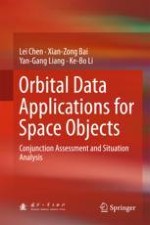2017 | OriginalPaper | Chapter
5. Calculation of Collision Probability
Authors : Lei Chen, Xian-Zong Bai, Yan-Gang Liang, Ke-Bo Li
Published in: Orbital Data Applications for Space Objects
Publisher: Springer Singapore
Activate our intelligent search to find suitable subject content or patents.
Select sections of text to find matching patents with Artificial Intelligence. powered by
Select sections of text to find additional relevant content using AI-assisted search. powered by
